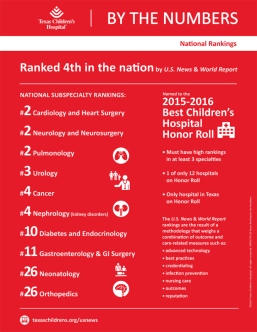As many of you can see, Tower E is progressing very well. This new inpatient pediatric tower is the realization of the CareFirst initiative we launched a few years ago to provide a solution that will ensure our ability to care for children who will need our specialized services in the future. The tower will house care and services for some of our most critically ill patients, and allow us to provide them with the best experience possible as we help them heal.
 We are looking forward to opening the doors of the tower next year. But today, I am thrilled to share an exciting milestone. We have reached the point in the construction process where we need to determine the official name of the new building. After careful consideration, I am pleased to announce that we have arrived at the name Legacy Tower.
We are looking forward to opening the doors of the tower next year. But today, I am thrilled to share an exciting milestone. We have reached the point in the construction process where we need to determine the official name of the new building. After careful consideration, I am pleased to announce that we have arrived at the name Legacy Tower.
This name represents our founding and everyone who led the charge and the fundraising to create a hospital in Houston dedicated to the care of children. In the 1940s, a small group of Houston physicians, philanthropists and community leaders saw a need for a pediatric hospital and went to work to bring it to fruition. Proceeds from The Pin Oak Charity Horse Show in 1947 helped establish the Texas Children’s Hospital Foundation, and in 1950, Leopold L. Meyer secured a $1 million gift from Lillie and Jim Abercrombie to build Texas Children’s Hospital. There was only one condition – that it be “open to every sick or hurt child with no restrictions on religion, color, or whether or not they can pay.” Texas Children’s Hospital began with that promise, and a rich legacy began to take shape.
Legacy Tower also will be a tribute to the many years of dedicated service our Board of Trustees and Board leaders have provided to the hospital. We have been blessed with the visionary, aspirational leadership of dedicated Board members since the hospital’s founding. And to this day, we continue to reap the rewards of a Board just as intently focused on the mission of this hospital as our founders were and who are as passionate about exceptional patient care as our physicians, nurses and employees. Texas Children’s has no doubt flourished because of the legacy of their incredible leadership.
And finally, Legacy Tower represents all of the advancements in pediatric medicine that have occurred here at Texas Children’s. From the first successful separation of twins conjoined at the liver and pericardium in 1965 to the most recent successful separation of the beautiful Mata conjoined twins, Adeline and Knatalye, and every step in between, Texas Children’s physicians and surgeons have pioneered breakthrough treatments. They revolutionized care for children and women around the world, continuing the rich legacy that began simply as dreams and ambitions decades ago.
We are very excited about Legacy Tower and all the patients and families who will receive care in this wonderful new space. Most importantly, we are grateful because opening Legacy Tower will mean never having to say no to a child who needs the complex, highly advanced care that only Texas Children’s can provide. This new tower, anchored proudly in the heart of the Texas Medical Center, will be a place of hope and healing for children from all over the world. And for us, it will be a reminder of all those who came first, dreamed big and worked so very hard so that we might be here today, tomorrow and 100 years from now, achieving the unthinkable. This is Texas Children’s legacy.



